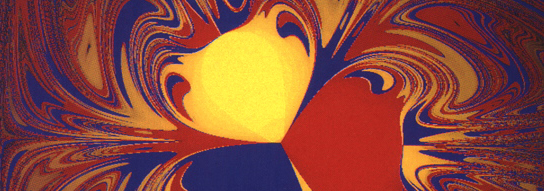"The question, at which point we draw the line between living and non-living is not a scientific question.The line between living and non-living at the beginning of evolution is arbitrary, just as the line between human and non-human primates at the end of evolution is arbitrary.The task of science is not to define the exact position of the line but to understand how it came to be crossed."
Read Morecomplexity
aggregate/systematic
"one of the most important tasks of Renaissance philosphy and mathematics was the creation, step by step, of the conditions for a new concept of space. The task was to replace aggregate space by system space ." (Cassirer, Individual and Cosmos p.182) (cf smooth / striated) (cf perspective )
Read Morecovid virus + antibodies
antibodies
An Antibody is a large protein molecule which latches on to and neutralizes foreign invaders such as bacteria and viruses. Each antibody acts only on a very specific target molecule, known as an antigen. (It can also coat microbes in a way to make them palatable to scavenger cells such as microphages.)
Read Moreart/science
The French zoosystéician Louis Bec argues that "With the advent of the sciences of the "artificial" and of communication, as well as the explosion of the technosciences and the sciences of the living a "lieu" (site or place) has emerged in which the total integration of arts, sciences, and technology can be achieved. There are now two different "epistemological poles" that encompass this integration. The first strives to link "poetic", "symbolic" descriptions of nature's mechanisms to scientific ones, producing " metaphorical expressions". (cf Gaia) The second involves activities ( cybernetics, artificial intelligence,...) which, among other ends, ultimately aim to simulate and act on the world, to better understand it by transforming it. (See Artificial Life II)
Read MoreAttractors
Attractors are geometric forms that characterize long-term behaviour in the phase space. Roughly speaking, an attractor is what the behaviour of a systems settles down to, or is attracted to. They are globally stable in the sense that the system will return if perturbed off the attractor, as long as it remains within the basin of attraction.
Read MoreAutocatalysis
Catalysts are chemical substances that modify reaction rates without themselves being changed in the process. Their kinetics are characterized by threshold and amplification phenomena. Enzymes are the major class of biological catalysts.
Read MoreAutopoesis
Autopoesis is both a concept about self-maintaining systems, especially biological ones, and an epistemological theory about cognition and self-reference.
Read MoreB/Z Reaction

Chemical reactions do not generally display dynamic patterns or spatial order. The Belousov-Zhabotinsky reaction, discovered in 1951, may be the first completely understandable laboratory example of pattern formation in a chemical system that involves nothing more than chemical reaction and molecular diffusion. That same year, in 1951, Alan Turing investigated the theoretical possibilities of pattern formation by reaction/diffusion as "The chemical basis of Morphogenesis." The B/Z reaction is an example of a chemical system that shows spatial, periodic and wave properties that suggests that morphogenetic self-organization might follow similar pathways in both inorganic and organic systems. (cf. Slime Mold)
from Arthur T. Winfree, When Time Breaks Down, p. 168
basin of attraction

The phase space of a particular dynamical system is partitioned into one or many basins of attraction , perhaps intimately intertwined, each with its own attractor .
basins of attraction for a pendulum swinging over three magnets. (from Peitgen, Jürgens, and Saupe, Chaos and Fractals)
bifurcation
A bifurcation occurs when an attractor changes qualitatively with the smooth variation of a control parameter. Physically, bifurcations denote phase transitions from a state of equilibrium to new possible states of equilibria. (see also singularities)
Read Morecatastrophe
Catastrophe theory is an attempt to go beyond classical physics -- the physics of structurally stable systems -- and to provide a mathematical framework for discontinuous processes. It was primarily developed by René Thom. Thom developed catastrophe theory as a mathematical way of addressing the work on morphogenesis done by C.H. Waddington in the 1950's.
Read MoreCellular Automata
Cellular Automata were invented by Stanislaw Ulam in the late 1940's and used by John von Neumann in his theoretical investigations of self- replication in machines. A cellular automaton is a lattice of finite automata that all obey transition functions defined by the local context of each cell at any given time.
Read MoreChaos
A deterministic system is one whose future states are completely fixed by its current state and its rule of dyamical motion. Determinism has historically been linked to prediction, and the laws governing planetary motion became the paradigmatic example of determinism and predictibility. (cf. clock) Thus Pierre Simon de Laplace, following Newton, believed that " Given for one instant an intelligence which could comprehend all the forces by which nature is animated and the respective positions of the beings which compose it...nothing would be uncertain, and the future as the past would be present to its eyes."
Read MoreUntitled work on paper, Maureen McQuillan 2019
Clinamen
According to the Lucretian account of chaos falling into order by the chance concourse of atoms -- Sometimes, wrote Lucretius, at uncertain times and places, the eternal, universal fall of the atoms is disturbed by a very slight deviation - the "clinamen." The resulting vortex gives rise to the world, to all natural things.
Read Moreclosed/open systems
A closed system in statistical thermodynamics is one in which the number of particles as well as the total energy are fixed by boundary conditions. Closed systems systems tend towards equilibrium and to increse in entropy.
Read Morecomplexity
The modern awakening of interest in complexity as a science began in Vienna in 1928, with Ludwig von Bertalanffy's largely descriptive graduate thesis on living organisms as systems. A few years earlier Alfred North Whitehead had described his similar vision of a "philosopy of organism" in Science and the Modern World. Whitehead describes his theory of the organic conception of nature as based on "self-knowledge of our bodily event." This total bodily event is on the same level as all other events, except for an unusual complexity and stability of inherent pattern. (Science and the Modern World, p. 73)
Read Morecontinuity/discontinuity

For Georges Bataille, (sexual)"Reproduction implies the existence of discontinuous beings." (Erotism, p.12) Each being is distinct from all others, including its parents, who are distinct from each other. For Bataille death means the continuity of being and is brought into play by reproduction. Death is the end of discontinuous being, of the being formed at the moment when the discontinuous entities of sperm and egg unite to form a new continuity, when two become one, and a new entity is formed from the fatal fusion. The fascination with both reproduction and death is the dominant element in Eroticism.
Read MoreCybernetics
Cybernetics: (derives from the Greek word for steersman, which was used by Plato in the sense of "government."):The technology of process control was developed by Norbert Weiner into "the field of control and communication theory (based on statistical information) , whether in the machine or animal" . The terms was first introduced in 1947. See Wiener Cybernetics.
Read MoreCyberscience
Evelyn Fox Keller calls information theory, cybernetics, systems analysis, operations research, and computer science all parts of "cyberscience."
Read Moredimension
Some different mathematical notions of dimension are: correlation dimension, embedding dimension, topological dimension, Hausdorff dimension, fractal dimension, self-similarity dimension, box-counting dimension, capacity dimension, information dimension. (see scientific space)

